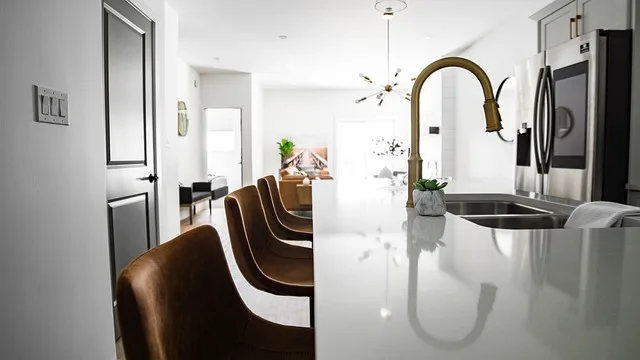First things first, grab a screwdriver. Most cabinet hinges are held in place with just a few screws. If your doors are sagging, it’s likely that some screws have loosened over time. Simply tighten them up, and you might be surprised at how much better your doors behave. It’s like giving them a little pep talk!
If tightening doesn’t do the trick, check for any damage. Sometimes, the hinges themselves can wear out or break. If that’s the case, you’ll need to replace them. Don’t fret! You can find replacement hinges at any hardware store. Just make sure to take the old hinge with you to match it up. It’s like finding the perfect pair of shoes; you want them to fit just right!
Now, if your cabinet doors are still misaligned after all that, it’s time for a little adjustment. Most hinges have a few adjustment screws that allow you to tweak the position of the door. Think of it as fine-tuning a musical instrument; a little twist here and there can make a world of difference.
And if you’re dealing with soft-close hinges, they can sometimes get gunky. A quick wipe with a damp cloth can clear out any debris, allowing them to glide smoothly again. It’s like giving your hinges a refreshing spa day!
So, roll up your sleeves and give those cabinet hinges some love. You’ll be amazed at how a little maintenance can transform your kitchen!
Unlocking the Secrets: A Step-by-Step Guide to Fixing Kitchen Cabinet Hinges
First things first, let’s gather our tools. You’ll need a screwdriver, a level, and maybe a little wood glue if things are really out of whack. Think of these tools as your trusty sidekicks, ready to help you tackle this kitchen conundrum.
Now, take a good look at those hinges. Are they loose? Rusty? Or maybe they just need a little adjustment? If they’re loose, simply tighten the screws. It’s like giving your hinges a little pep talk—“You can do this!” If they’re rusty, a bit of oil can work wonders. Just a drop or two, and it’s like a spa day for your cabinets.

Next, if the door is misaligned, grab that level. Place it against the cabinet door to see where the issue lies. Is it tilting to one side? Adjust the hinge screws accordingly. It’s like fine-tuning a guitar; a little twist here and there can make all the difference.
If you find that the hinge itself is damaged, don’t fret! Replacing it is as simple as unscrewing the old one and screwing in a new one. It’s like swapping out an old pair of shoes for a fresh, stylish pair.
So, roll up your sleeves and get ready to transform your kitchen. With just a few simple steps, you’ll have those cabinet doors swinging smoothly, and you’ll feel like a DIY superstar!
Hinge Hiccups? Discover Simple Solutions to Revive Your Kitchen Cabinets

First off, let’s talk about those squeaky hinges. They can sound like a rusty old gate, right? A little bit of lubricant can work wonders here. Grab some WD-40 or even olive oil if you’re in a pinch. Just a few drops on the hinge and voila! You’ll be amazed at how smoothly your cabinet doors glide open and shut.
Now, if your cabinets are sagging or misaligned, it’s time to channel your inner handyman. Check the screws on the hinges—are they loose? Tightening them can often do the trick. Think of it like giving your cabinets a little hug; they just need some support to stand tall again. If the screws are stripped, don’t fret! You can use toothpicks or wooden dowels to fill the holes before re-screwing. It’s a quick fix that can save you from a cabinet catastrophe.
And what about those stubborn doors that just won’t stay closed? A simple magnetic catch can be your best friend here. It’s like a little bouncer for your cabinets, ensuring everything stays in place. Just install it on the inside of the cabinet, and you’ll never have to worry about a door swinging open unexpectedly again.
So, whether it’s squeaks, sagging, or stubborn doors, tackling hinge hiccups doesn’t have to be a daunting task. With a few easy fixes, you can breathe new life into your kitchen cabinets and keep them functioning like new. Who knew cabinet care could be this simple?
From Squeaks to Smooth: Expert Tips for Repairing Kitchen Cabinet Hinges
First off, grab some lubricant. Think of it as a magic potion for your hinges. A few drops of silicone spray or even good old WD-40 can work wonders. Just spray it on the hinge and swing the door back and forth a few times. It’s like giving your cabinets a refreshing spa day!
Next, check for any loose screws. Sometimes, a little tightening is all it takes to restore harmony. Use a screwdriver to snug them up. It’s like giving your cabinets a gentle hug—tightening them up will help them feel secure and stable.
If your hinges are still stubborn, consider removing them for a deeper clean. Take them off, wipe away any grime, and inspect for wear and tear. It’s like giving your hinges a thorough check-up. If they’re too worn out, it might be time for a replacement. Don’t fret; new hinges are easy to find and can give your cabinets a fresh look.
Lastly, don’t forget about alignment. If your cabinet doors are misaligned, it can cause unnecessary strain on the hinges. Adjusting them is like straightening a picture frame—just a little tweak can make everything look and function better.
So, roll up your sleeves and get ready to turn those squeaks into smooth, effortless movements. Your kitchen will thank you!
DIY Delight: Transform Your Kitchen with These Easy Hinge Fixes
First off, let’s talk about those pesky loose hinges. You know the ones—every time you open a cabinet, it feels like a mini earthquake. A quick fix is often just a matter of tightening the screws. Grab a screwdriver and give those screws a little love. It’s like giving your cabinets a refreshing cup of coffee; they’ll perk right up!
But what if your hinges are still misbehaving? No worries! You can shim them up. Just take a small piece of cardboard or a matchstick and slide it behind the hinge. It’s like giving your cabinet a little boost, helping it stand tall and proud. You’ll be surprised at how this tiny tweak can make a world of difference.
Now, if you’re feeling a bit adventurous, consider replacing those old hinges with some stylish new ones. It’s like swapping out an old pair of shoes for a trendy new pair. Not only will your cabinets function better, but they’ll also look fabulous! Choose finishes that complement your kitchen’s vibe—brushed nickel, matte black, or even a pop of color can do wonders.
The Ultimate Kitchen Cabinet Hinge Repair Guide: Save Money and Time!
First off, let’s talk about the hinges themselves. They’re the unsung heroes of your cabinets, holding everything together. Over time, they can get loose or even break, but that doesn’t mean you have to replace the entire cabinet. A simple adjustment might do the trick! Grab a screwdriver and check if the screws are loose. Tightening them can often restore that smooth, effortless swing.
Now, if you find that the hinge is damaged, don’t panic! Replacing a hinge is easier than you think. Just head to your local hardware store, and you’ll find a variety of hinges that can fit your cabinets. It’s like shopping for clothes—just make sure you get the right size! Once you have your new hinge, it’s a straightforward swap. Remove the old one, line up the new one, and screw it in place. Voila! You’ve just given your cabinet a new lease on life.
But what if the cabinet door is still misaligned after replacing the hinge? No worries! Most hinges have adjustment screws that allow you to tweak the door’s position. It’s like fine-tuning a musical instrument—just a little twist here and there, and you’ll have everything in harmony again.
So, why let a squeaky cabinet ruin your day? With a few simple tools and a bit of patience, you can turn that cabinet chaos into a smooth, functional space.
Frequently Asked Questions
What Are the Common Signs of Damaged Kitchen Cabinet Hinges?
Common signs of damaged kitchen cabinet hinges include difficulty in opening or closing doors, misalignment of cabinet doors, visible rust or corrosion on the hinges, and unusual noises such as squeaking or grinding when operating the doors. Additionally, if the doors sag or do not stay closed, it may indicate that the hinges are worn or broken.
How Can I Replace Broken Kitchen Cabinet Hinges?
To replace broken kitchen cabinet hinges, first remove the cabinet door by unscrewing the old hinges. Choose new hinges that match the size and style of the old ones. Align the new hinges with the pre-drilled holes or mark new ones if necessary. Secure the hinges to the cabinet and door using screws, ensuring they are tight. Finally, reattach the cabinet door to the frame and test for proper alignment and functionality.
Are There Tips for Maintaining Kitchen Cabinet Hinges?
To maintain kitchen cabinet hinges, regularly clean them with a damp cloth to remove dust and grease. Lubricate the hinges with a silicone spray or a few drops of oil to ensure smooth operation. Check for loose screws and tighten them as needed. Avoid overloading cabinets to prevent strain on the hinges. Regular maintenance can extend the life of your cabinet hardware.
What Tools Do I Need to Fix Kitchen Cabinet Hinges?
To fix kitchen cabinet hinges, you will need a few essential tools: a screwdriver (either flathead or Phillips, depending on the screws), a drill for any new holes, a measuring tape for accurate placement, wood glue for repairs, and possibly a level to ensure proper alignment. Having these tools on hand will help you efficiently address any hinge issues.
How Do I Adjust Misaligned Kitchen Cabinet Hinges?
To adjust misaligned kitchen cabinet hinges, first, identify the type of hinge used. Use a screwdriver to loosen the screws on the hinge slightly. Adjust the cabinet door by moving it up, down, or sideways to align it properly with the adjacent doors or cabinet frame. Once aligned, tighten the screws securely. Check the alignment by opening and closing the door to ensure it operates smoothly.